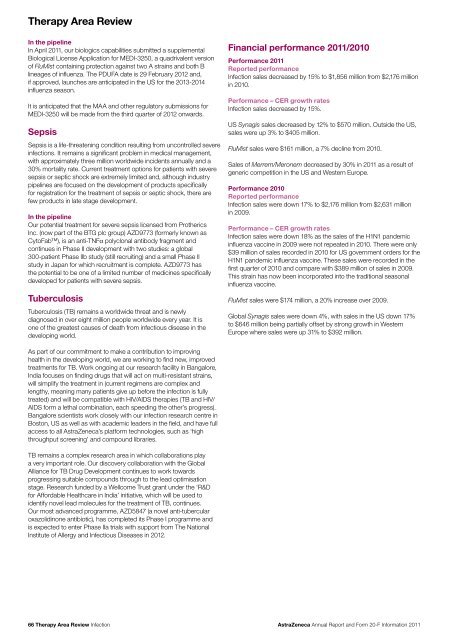AstraZeneca Annual Report and Form 20-F Information 2011
AstraZeneca Annual Report and Form 20-F Information 2011
AstraZeneca Annual Report and Form 20-F Information 2011
- No tags were found...
You also want an ePaper? Increase the reach of your titles
YUMPU automatically turns print PDFs into web optimized ePapers that Google loves.
Therapy Area ReviewIn the pipelineIn April <strong>20</strong>11, our biologics capabilities submitted a supplementalBiological License Application for MEDI-3250, a quadrivalent versionof FluMist containing protection against two A strains <strong>and</strong> both Blineages of influenza. The PDUFA date is 29 February <strong>20</strong>12 <strong>and</strong>,if approved, launches are anticipated in the US for the <strong>20</strong>13-<strong>20</strong>14influenza season.It is anticipated that the MAA <strong>and</strong> other regulatory submissions forMEDI-3250 will be made from the third quarter of <strong>20</strong>12 onwards.SepsisSepsis is a life-threatening condition resulting from uncontrolled severeinfections. It remains a significant problem in medical management,with approximately three million worldwide incidents annually <strong>and</strong> a30% mortality rate. Current treatment options for patients with severesepsis or septic shock are extremely limited <strong>and</strong>, although industrypipelines are focused on the development of products specificallyfor registration for the treatment of sepsis or septic shock, there arefew products in late stage development.In the pipelineOur potential treatment for severe sepsis licensed from ProthericsInc. (now part of the BTG plc group) AZD9773 (formerly known asCytoFab), is an anti-TNFα polyclonal antibody fragment <strong>and</strong>continues in Phase II development with two studies: a global300-patient Phase IIb study (still recruiting) <strong>and</strong> a small Phase IIstudy in Japan for which recruitment is complete. AZD9773 hasthe potential to be one of a limited number of medicines specificallydeveloped for patients with severe sepsis.TuberculosisTuberculosis (TB) remains a worldwide threat <strong>and</strong> is newlydiagnosed in over eight million people worldwide every year. It isone of the greatest causes of death from infectious disease in thedeveloping world.Financial performance <strong>20</strong>11/<strong>20</strong>10Performance <strong>20</strong>11<strong>Report</strong>ed performanceInfection sales decreased by 15% to $1,856 million from $2,176 millionin <strong>20</strong>10.Performance – CER growth ratesInfection sales decreased by 15%.US Synagis sales decreased by 12% to $570 million. Outside the US,sales were up 3% to $405 million.FluMist sales were $161 million, a 7% decline from <strong>20</strong>10.Sales of Merrem/Meronem decreased by 30% in <strong>20</strong>11 as a result ofgeneric competition in the US <strong>and</strong> Western Europe.Performance <strong>20</strong>10<strong>Report</strong>ed performanceInfection sales were down 17% to $2,176 million from $2,631 millionin <strong>20</strong>09.Performance – CER growth ratesInfection sales were down 18% as the sales of the H1N1 p<strong>and</strong>emicinfluenza vaccine in <strong>20</strong>09 were not repeated in <strong>20</strong>10. There were only$39 million of sales recorded in <strong>20</strong>10 for US government orders for theH1N1 p<strong>and</strong>emic influenza vaccine. These sales were recorded in thefirst quarter of <strong>20</strong>10 <strong>and</strong> compare with $389 million of sales in <strong>20</strong>09.This strain has now been incorporated into the traditional seasonalinfluenza vaccine.FluMist sales were $174 million, a <strong>20</strong>% increase over <strong>20</strong>09.Global Synagis sales were down 4%, with sales in the US down 17%to $646 million being partially offset by strong growth in WesternEurope where sales were up 31% to $392 million.As part of our commitment to make a contribution to improvinghealth in the developing world, we are working to find new, improvedtreatments for TB. Work ongoing at our research facility in Bangalore,India focuses on finding drugs that will act on multi-resistant strains,will simplify the treatment in (current regimens are complex <strong>and</strong>lengthy, meaning many patients give up before the infection is fullytreated) <strong>and</strong> will be compatible with HIV/AIDS therapies (TB <strong>and</strong> HIV/AIDS form a lethal combination, each speeding the other’s progress).Bangalore scientists work closely with our infection research centre inBoston, US as well as with academic leaders in the field, <strong>and</strong> have fullaccess to all <strong>AstraZeneca</strong>’s platform technologies, such as ‘highthroughput screening’ <strong>and</strong> compound libraries.TB remains a complex research area in which collaborations playa very important role. Our discovery collaboration with the GlobalAlliance for TB Drug Development continues to work towardsprogressing suitable compounds through to the lead optimisationstage. Research funded by a Wellcome Trust grant under the ‘R&Dfor Affordable Healthcare in India’ initiative, which will be used toidentify novel lead molecules for the treatment of TB, continues.Our most advanced programme, AZD5847 (a novel anti-tubercularoxazolidinone antibiotic), has completed its Phase I programme <strong>and</strong>is expected to enter Phase IIa trials with support from The NationalInstitute of Allergy <strong>and</strong> Infectious Diseases in <strong>20</strong>12.66 Therapy Area Review Infection<strong>AstraZeneca</strong> <strong>Annual</strong> <strong>Report</strong> <strong>and</strong> <strong>Form</strong> <strong>20</strong>-F <strong>Information</strong> <strong>20</strong>11










